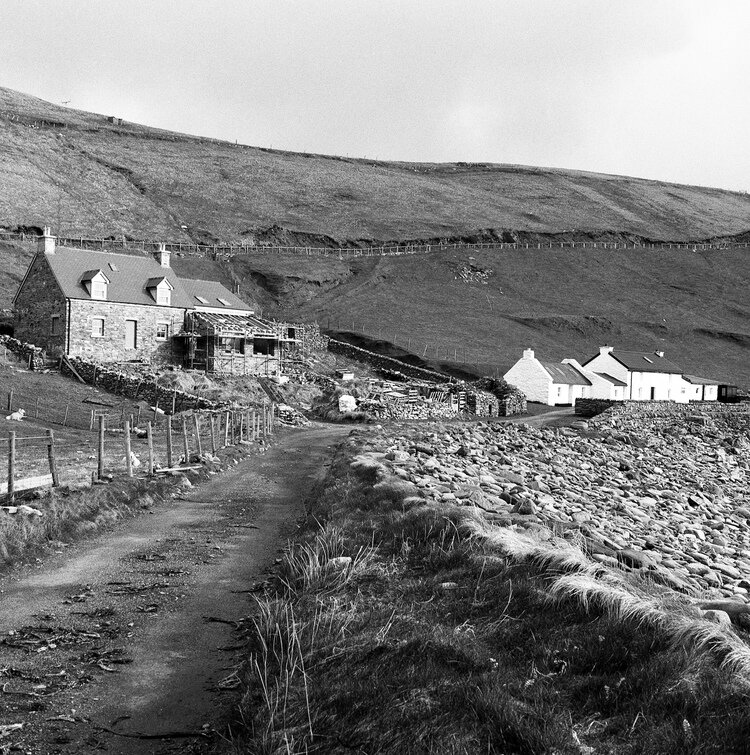Place and Stimmung
BETWEEN 2009 AND 2014 I WAS SOMEWHAT forced to become a landscape photographer. As I was working on my graduate degree in geography, a particular interpretation of research ethics rules I had to work under stipulated that I could not take any photographs of people for my research without a very complicated and practically impossible consent process. (It’s a story for another day.) My research took me to small islands off the coast of Newfoundland, to Croatia, and Shetland Islands. There was no way I wouldn’t make any photographs. So, I acquired some medium format cameras and a lot of 120 and 135 black and white film and created a series of photos of small island landscapes. The islanders, as per my university’s ethics committee request, got erased from existence.
The remarkable thing is that nobody ever pointed out that the islanders were missing from those photographs in a thesis based on the idea that islands should be studied on their own terms respecting their unique cultural, ecological, and social characteristics. The fact that the islanders were deliberately erased from those photographs bothers me to this day. Those islands, those places, would not be what they are if people did not dwell there.
Anne Buttimer, an Irish geographer, has a lovely definition of what it means to dwell in a place: “To dwell implies more than to inhabit, to cultivate, or to organize space,” she writes. “It means to live in a manner which is attuned to the rhythms of nature, to see one’s life as anchored in human history and directed toward a future, to build home which is the everyday symbol of a dialogue with one’s ecological and social milieu.”
Because I could not photograph islanders, I focused on trying to capture what such dwelling means in each of the places I encountered. I tried to make visually concrete what Colombian-American anthropologist Arturo Escobar called “sedimented social structures and cultural practices” that make up a place.
Norwegian architect Christian Norberg-Schulz wrote a fantastic book on place and place-making called Genius Loci: Towards a phenomenology of architecture (PDF) where he explains two concepts that should be just as important to photographers as they are to architects. Genius Loci, or the spirit of the place, is “a concrete reality” we need “to face and come to terms with” in our daily life. It is that that makes space a place and gives it a stimmung. Stimmung is untraslatable into English. It is sort of character or mood of the thing or place, it “forms a background to acts and occurances,” it is always present and every true place has it.
Good writers are masters at giving us a stimmung, a mood, their stories take place in. Any good novel will provide an example. Here is the opening paragraph of Fyodor Dostoevsky’s The Idiot:
Towards the end of November, during a warm spell, at around nine o’clock in the morning, a train of the Petersburg–Warsaw line was approaching Petersburg at full steam. It was so damp and foggy that dawn could barely break; ten paces to right or left of the line it was hard to make out anything at all through the carriage windows. Among the passengers there were some who were returning from abroad; but the third-class compartments were more crowded, and they were all petty business folk from not far away. Everyone was tired, as usual, everyone’s eyes had grown heavy overnight, everyone was chilled, everyone’s face was pale yellow, matching the color of the fog.
You would think that creating stimmung in photographs would be straightforward, but it turns out to be easier said than done. The photographers who deliberately set out to do it employ a variety of techniques and tools. I think Sally Mann in her work Battlefields successfully sets the troubling mood as she examines the issues of race and slavery in American South. She uses deliberately imperfect wet collodion process to create dark, moody photographs depicting American Civil War battlefields. Tomas van Houtryve in his series Blue Sky Days uses drones to capture Americans in everyday situations that in a place like Afghanistan or Northern Pakistan could easily become targets of a drone attack. The photographs are almost abstract, but utterly unsettling in their context.
Donovan Wylie’s work Outposts was made with a large format camera in Afghanistan depicting military installations within the overwhelmingly beautiful and expansive landscape creating simultaneously a sense of awe at the natural setting and the futility of the military operations still under way.
Belgian photographer Harry Gruyaert in his work Edges created a style and a colour palette that proved to be brilliant at creating a stimmung for the entire work.
There are other more or less successful examples of capturing the stimmung — the mood, feel, and character of a place. At this point I have no idea what that is going to look like as part of the project I am working on. Given my increasingly problematic allergy to photo chemicals, it’s probably safe to say that film and wet plates are not likely to be the tools I will employ. Everything else for now is a fair game. ✖︎




